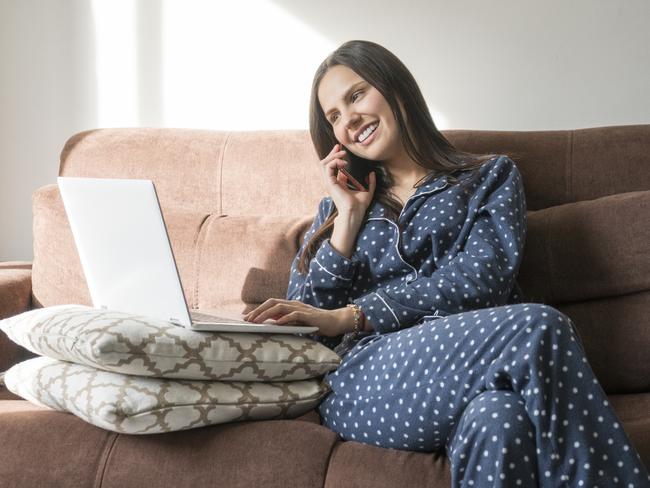What we really think of working from home
Australian workers are saving time and money while working from home, but one business expert believes the “trakky daks mentality” could end up costing us in the long run.
Working from home is saving most Australians an hour a day on commuting times and an average of $59 per week, new research has found.
A survey of almost 500 workers by consultancy Bastion Insights found that the average Australian worker had slashed $55 from their weekly travel bills, and the same amount on weekly incidentals, for a total of $110. But they were also incurring an average of $51 in extra costs per week at home, leaving a net benefit of $59.
Workers had also spent an average of $154 in one-off costs to set up a home office environment.
Almost one in five respondents (18 per cent) said they were saving more than two hours in commuting times each workday – although not everybody viewed the recovered time as a positive.
“I never thought I’d say this, but I actually miss the morning commute,” one respondent told the Bastion Insights team. “It helps me separate my time at work from my life at home.”

Survey recipients revealed deep differences in their views about working from home, with 62 per cent saying they were more productive in the office environment.
The 38 per cent who reported getting more work done while at home tended to be older employees.
Sydney-based digital life and wellbeing analyst Dr Joanne Orlando said despite the obvious distractions of children at home, digital distractions such as social media, online shopping and porn were all having an impact on productivity.
“We know digital distraction is one of the major issues that eat into our productivity in the office, but even more so at home, when you’re not monitored and you don’t have colleagues walking past,” she said.
Studies showed that it took workers an average of 23 minutes to fully focus on a task after a distraction, she added.

Business expert Peter Switzer told News Corp that a lack of productivity could also be attributed to what he called “the trakky daks mentality”.
“When you’re sitting around in trakky daks, it can be great when we’ve got no distractions and we’re in the zone. But when I get dressed up in a suit and tie, all that sort of stuff, there’s a discipline … and it may well be the same discipline that the army thinks they get out of soldiers in uniform,” he said.
“We dress for the occasion and sometimes react and act as a consequence of how we’re dressed.”
Employees who could demonstrate good productivity working from home would be in a good position to negotiate more flexible arrangements with their bosses in future, he suggested.
The Bastion Insights research suggested many Australian workers would actually prefer to combine working from home and from the office once lockdown restrictions were eased.
Dr Orlando said this likely new mix of work could have profound influences on where Australians lived.
“We won’t have to concentrate living in the major cities. We can live in more regional ways if we’re not commuting every day,” she said. “It’s something that will be looked at very seriously now.”


The Australian Institute of Business, headquartered in Adelaide, might be typical of how firms manage the shift to accommodate more home-working arrangements.
“Our first priority is the health and wellbeing of our staff members, and we know some have expressed concern about catching public transport and whether or not that’s going to increase their risk,” chief executive Paul Wappett said.
“We won’t get to a situation in which we will have 100 per cent of our staff on site ever again. We’re deliberately looking at how it is that we can always have about 20 per cent of our staff off-site, just as part of business continuity planning, and in the early days we’ll start with about 25-30 per cent of our staff coming in.
“They will be groups that need to collaborate with each other and interact with each other to get things done cross functionally.”
Daily temperature tests of staff and written declarations of health were possibilities being examined for the return of staff to shared office spaces, Mr Wappett said.
